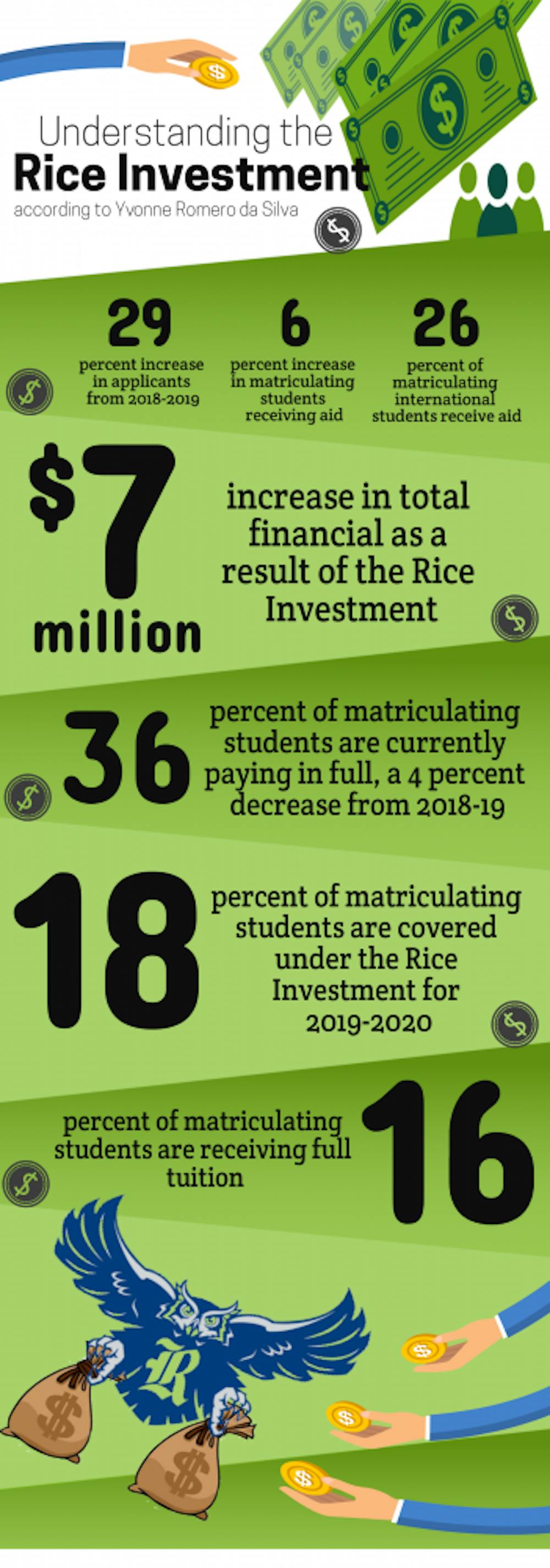The Rice Investment: Students receive, respond to aid and expectations

While the Rice Investment caused an increase in the number of applications and students receiving need-based financial aid, responses to the Rice Investment have been mixed.
The Rice Investment, which took effect for the 2019-2020 school year, resulted in a 29 percent rise in the number of applications and an increase from 44 percent to 50 percent of matriculating students receiving need-based financial aid, according to Vice President for Enrollment Yvonne Romero da Silva.
“We were already anticipating an increase in applications, but I’d say probably half ... of the overall increase in applications came as a result of this new financial aid policy,” Romero da Silva said. “And that increase came from all over, all over the country and we had increased interest all over the world as well across all the disciplines that we have here at Rice.”
There was an overall increase of $7 million of financial aid granted, according to Romero da Silva. The number of students receiving financial aid at each income threshold covered by the Rice Investment increased as well, she said.
Stephanie Kwak, a South Korean international student, said that Rice has not been generous in giving financial assistance to the international community.
“Now that they’re increasing the portion of financial aid to ... the people who have the citizenships, then that means they need more money out of us,” Kwak, a Lovett College junior, said. “Tuition increased a lot.”
The cost of attendance at Rice for the 2019-2020 school year rose to $63,252, a 3.1 percent increase from the year before.
The Rice Investment does not apply to international students, according to Vice President for Finance Kathy Collins. There are, however, options for international students in situations of financial hardship, Collins said.
According to Romero da Silva, Rice meets 100 percent of need for international students admitted with aid. Twenty-six percent of international students receive financial aid, according to Collins.
Jake Bhoi, a McMurtry College senior, said that he received less aid under the Rice Investment compared to years before.
“On the surface level, the amount of aid that I was given looks basically the same because they increased my work study to an obscene amount that wasn’t something that was possible, since all Rice jobs pay between $8 and $11 an hour,” Bhoi said.
Current job postings on the Rice job board have salaries ranging from $8-$12 per hour, according to the Office of Financial Aid website.
Collins said that the only reason students would receive less aid is that their family circumstances changed, such as an increase in family income or a graduation of a sibling from college. Although his family situation has remained unchanged, Bhoi said that his aid still decreased.
“Our estimated family contribution was lower this year than it was the year before. But even with that, the amount of aid was decreased from, I think there was like a $3,000 difference or a $4,000 difference,” Bhoi said. “Both of my siblings are still in college.”
Molly Wancewicz, a Brown College junior, said the replacement of student loans with grants through the Rice Investment was a significant improvement.
“My financial aid package is no longer aid where I have to pay it back and pay interest and worry about it all the time, but it’s like actually a grant that can alleviate the long-term costs,” Wancewicz said. “That was something that wasn’t as publicized about [the Rice Investment], but that has made a big difference for me.”
Wancewicz said that the method of setting income threshold cutoffs warrants further discussion.
“These income cutoffs ... mean vastly different things in different parts of the country,” Wancewicz said. “I’m from Silicon Valley in California, so my parents’ income and ... the same amount of money in say Texas or Oklahoma can afford vastly different things. So it seems like a one-size-fits-all approach that is well intentioned, but there definitely should be some fine-tuning there.”
Romero da Silva said that several factors went into consideration for the income thresholds, including the median United States income level and the median income for families with college-age students.
“We wanted to simplify the process by using terms our families would easily understand, like income and grant aid to cover tuition,” Romero da Silva said. “It’s giving them the knowledge up front that really makes the difference.”
Romero da Silva said the responses she has received from parents and students made her feel like Rice was doing the right thing.
“What’s really interesting is the anecdotal letters and messages that we would get from students and from parents,” Romero da Silva said. “I can recall one father writing thanking us for the Rice Investment because his daughter’s No. 1 dream was to come to Rice, but he was nervous to encourage her to apply because of the cost. But knowing that this is what they would qualify for, he’s like ‘go for it’ now.”
Romero da Silva said even students not directly benefiting from the Rice Investment have expressed appreciation for its mission of inclusivity.
“We even had students who wrote to us to say my family’s not going to qualify for the Rice Investment but I’m applying because I want to be at a place that’s willing to support families in this way,” Romero da Silva said.
Wancewicz said that she doesn’t have a strong opinion either way on the Rice Investment.
“I think they’re doing a good job of messaging Rice’s values of inclusion and accessibility, but I think they could probably improve on messaging the mechanics of their new financial aid program,” she said.
More from The Rice Thresher
Rice lands high on Niche, Forbes college ranking lists
Rice recently ranked No. 10 on Niche’s Best Colleges in America list and No. 12 on Forbes’ annual America’s Top Colleges list in 2026. It was also recognized in several categories by the Princeton Review, placing in the top 10 in four categories.
From post-human novels to augmented reality, Rice hires new faculty
Rice welcomed 97 new professors this fall across disciplines, including a posthumanist Harvard scholar, a husband-wife duo and a computer science professor who graduated from Rice thrice.

First public of the year reckons with threats of a dry campus
After a Dis-O that saw four times as many calls for intoxication-related transports of students to the hospital compared to the prior three years, Cory Voskanian, a Martel College socials head tasked with planning the first public of the year, said that he was feeling the pressure.


Please note All comments are eligible for publication by The Rice Thresher.